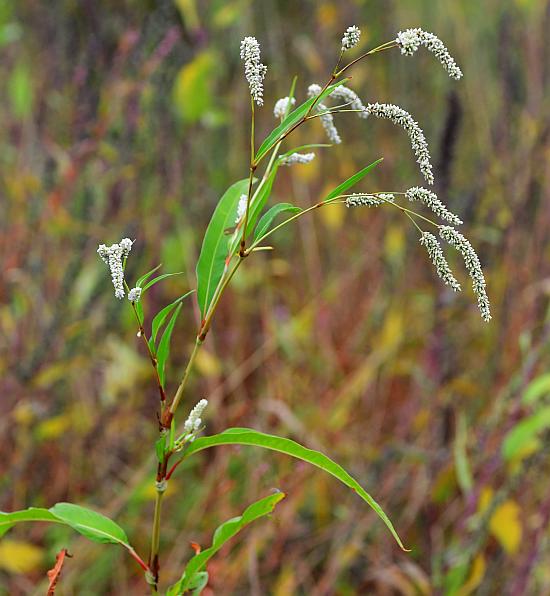Persicaria lapathifolia (L.) Delarbre
Pale Smartweed

Native
CC = 0
CW = 0
MOC = 66
© SRTurner
Persicaria lapathifolia (L.) DelarbrePale Smartweed | |
 |
Native CC = 0 CW = 0 MOC = 66 |
© SRTurner |
|
Family - Polygonaceae Habit - Taprooted annual forb. Stems - Ascending to erect, to 1.2 m, sometimes rooting at lower nodes, sometimes from a spreading base, glabrous or occasionally short-hairy toward the tip, the hairs sometimes gland-tipped. Ocreae persistent, usually tearing with age, 4-30 mm long, somewhat inflated toward the base, tan and papery throughout, truncate and slightly oblique at the tip, lacking a flange of tissue at the tip, the margin entire or nearly so, lacking bristles or occasionally with short, slender, extensions of the veins to 0.8 mm long, the surface glabrous or rarely appressed-hairy, not gland-dotted.
Leaves - Alternate, simple, petiolate. Petioles 0.1-1.8 cm long. Blades 3-12 cm long, 0.4-4.5 cm wide, lanceolate, angled or tapered at the base, angled or tapered to a sharply pointed tip, the upper surface usually glabrous, the undersurface glabrous or appressed-hairy along the main veins, unarmed, the undersurface with impressed glands, the upper surface sometimes with a reddish or purplish, crescent-shaped or triangular marking.
Inflorescences - Terminal and axillary, dense spikelike racemes, usually several to numerous per main stem, 3-8 cm long, 5-9 mm wide, ascending but strongly arched or nodding toward the tip, uninterrupted, the stalk 0.2-2.5 cm long, glabrous or more commonly hairy, the hairs gland-tipped. Ocreolae usually overlapping, the margins entire or with bristles 0.1-0.4 mm long, the surface glabrous, not gland-dotted.
Flowers - Perfect, 4-14 per fascicle, all similar. Perianth usually white to greenish white, urn-shaped, not gland-dotted, the tepals 4, 2-3 mm long, fused below the midpoint, the 3 nerves relatively prominent, the midnerve branched apically into an anchor-shaped pattern. Stamens 5 or 6, not exserted, the anthers pink or red. Styles 2-branched from near the base, not exserted, not persistent.
Fruits - Achenes 1.5-3.2 mm long, 1.5-2.8 mm wide, not or only slightly exserted, discoid or rarely 3-angled, beakless, the faces flat or slightly convex, 1 of the faces usually with a central hump, the surface smooth to finely pebbled, brown to black, shiny or dull. Flowering - June - November. Habitat - Streambanks, pond margins, sloughs, marshes, swamps, bottomland forest margins, crop fields, ditches, railroads, roadsides, open disturbed areas; sometimes emergent aquatics. Origin - Found in U.S. and Eurasia. Probably introduced in North America. Lookalikes - Broadly, other species of Persicaria and Polygonum. Other info. - This plant can get quite tall and is easily distinguished from other members of the genus by its nodding, whitish inflorescences. The leaves sometimes have a dark splotch in the center but this is not usual. The plant is common in wet areas across most of Missouri and the continental U.S. Its is tolerant of disturbance and often occurs in degraded habitats. The flowers of the plant are rarely found open. Photographs taken along the Current River, Shannon County, MO., 8-17-03 (DETenaglia); also at Columbia Bottoms Conservation Area, St. Charles County, MO, 8-4-2016, Otter Slough Conservation Area, Stoddard County, MO, 10-18-2017, and along the Katy Trail near Dutzow, Warren County, MO, 9-29-2020 (SRTurner). |